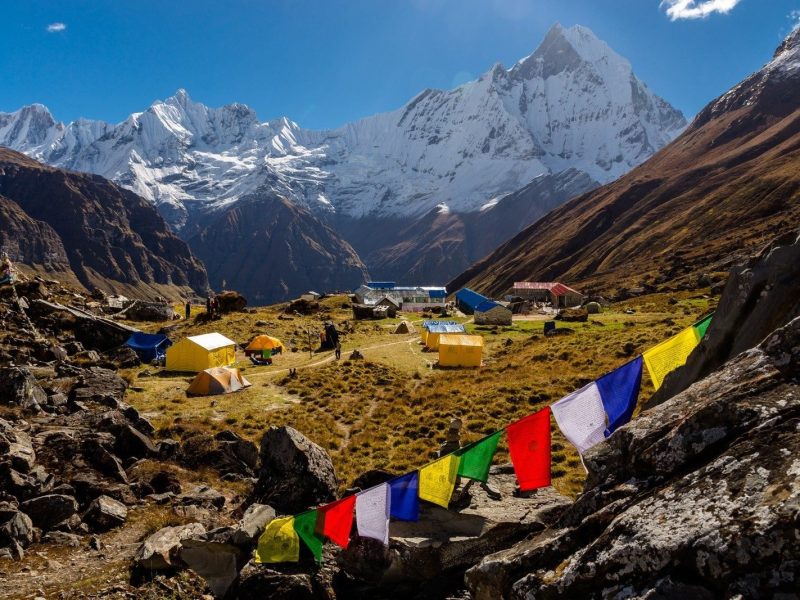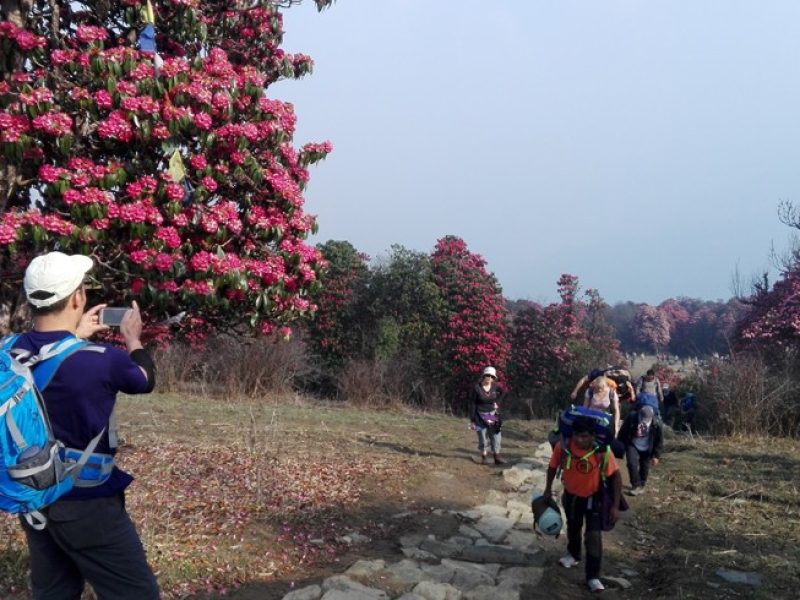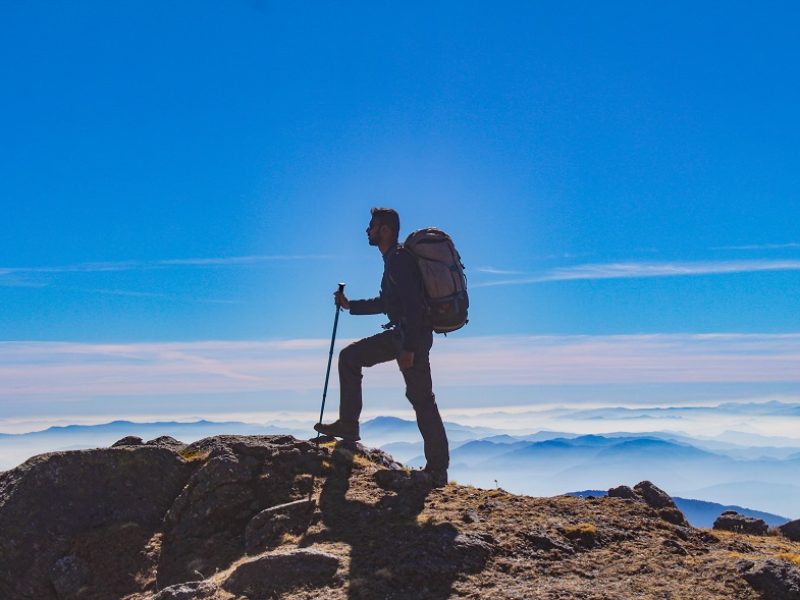Experience the enchanting Rhododendron Forest of Annapurna: Explore local culture and natural wonders on your trek.
Nepal is located in the Himalayas which is known for its natural beauty and diverse landscapes. The Annapurna region is a testament to Nepal’s beauty, attracts trekkers from around the world to explore its majestic peaks, tranquil valleys, and enchanting forests. The rhododendron forests, a defining feature of the region’s landscape, are a highlight of any trekking adventure.
The Annapurna Massif, with its towering summits reaching over 8,000 meters, dominates the skyline, inspiring a sense of reverence for the natural world. The valleys are a sanctuary of tranquility, with pristine rivers meandering through lush meadows and forests teeming with life.
The rhododendron forests also hold cultural significance for the Nepalese people, as the national flower of Nepal. The rhododendron is revered for its beauty and resilience, serving as a symbol of strength and endurance in the face of adversity.
For trekkers, the rhododendron forests of the Annapurna region offer a magical experience, a journey through a land of enchantment and wonder.
Why Visit Annapurna Region?
The Annapurna region is located in the Himalayas which is a must-visit destination for adventure seekers, nature lovers, and cultural enthusiasts. The region boasts majestic peaks like Annapurna I and Machhapuchhre, stunning views of snow and azure skies.

The landscape is diverse, with rhododendron forests blooming in spring. The region is rich in biodiversity, including rare and endangered species like the red panda and Himalayan thar.
It is also rich in cultural heritage, with a tapestry of ethnic groups, traditions, and customs. The region is also home to spiritual sanctuaries, offering peaceful moments of reflection. Trekking opportunities are available for all experience levels, from short trails to challenging high-altitude expeditions.
The region promotes sustainable tourism practices, minimizing environmental impact and benefiting local communities. Overall, the Annapurna region offers an unforgettable journey into the heart of the Himalayas.
The Route And Landscape Of Annapurna region
The Annapurna region offers a diverse and captivating landscape, with the Ghorepani Poon Hill trek being a popular route. The journey begins in Nayapul, a bustling town, and takes trekkers through picturesque villages, terraced fields, and lush forests.
The trail takes them through charming villages like Tikhedhunga, Ulleri, and Ghorepani, where they can immerse themselves in local culture and hospitality. The rhododendron forests, adorned with various species and sizes, transform the landscape into a kaleidoscope of colors during the spring season.
The trail ascends gradually towards Poon Hill, a renowned vantage point offering panoramic views of the Annapurna and Dhaulagiri ranges. Descending from Poon Hill, the trail continues through more rhododendron forests, eventually leading to the charming village of Ghandruk.
The trail winds back to Nayapul, completing the loop and offering an unforgettable adventure through the rhododendron forests of the Annapurna region.
The Rhododendron Experience While Trekking
The Annapurna region offers a breathtaking experience through its rhododendron forests, a natural wonder that captivates the senses and leaves a lasting impression on the soul. The forests come alive with vibrant blooms during the spring season, from March to April, displaying hues of pink, red, and white. 
The diverse array of rhododendron species, including Nepal’s national flower, the Rhododendron arboreum, and the Rhododendron campanulatum (bell-shaped), adds to the richness and enchantment of the trekking experience.
The scent of the rhododendron blossoms mingles with the earthy aroma of the forest floor, creating an olfactory symphony that enhances the trekking experience. Beyond the beauty of the blooms, the rhododendron forests also host a rich array of wildlife, including the red panda, Himalayan tahr, and various bird species.
The rhododendron holds special cultural significance for Nepal, as it is the national flower and a symbol of strength, endurance, and the beauty of the natural world.
Wildlife Encounters While Trekking
The rhododendron forests of Annapurna are a rich and diverse habitat for wildlife, including the elusive red panda, the Himalayan thar, and various bird species. The forests are home to the renowned Himalayan Monal, the national bird of Nepal, and other bird species such as eagles, vultures, pheasants, thrushes, warblers, and finches.
Trekkers can also encounter smaller mammals and reptiles such as the Himalayan langur, musk deer, squirrels, shrews, snakes, and lizards. Despite their abundance of wildlife, the forests face threats from human activities, habitat loss, and climate change. ![]()
Conservation efforts are underway to protect these ecosystems and the creatures that call them home. Local organizations, national parks, and government agencies are working together to promote sustainable tourism practices, protect critical habitats, and raise awareness about preserving Nepal’s biodiversity.
Encountering wildlife in the rhododendron forests of Annapurna is a thrilling and rewarding experience that adds an extra dimension to the trekking adventure.
Cultural Involvement In The Rhododendron Forest
Trekkers can experience cultural immersion in the rhododendron forests of the Annapurna region, connecting with local communities and experiencing traditional Nepalese culture. Villages like Ghorepani and Ghandruk offer glimpses into Nepalese hospitality and traditional cuisine.
Trekkers can stay in local teahouses and enjoy authentic Nepali cuisine, interacting with friendly locals. Travelers can witness traditional festivals and customs, such as Dashain, Tihar, and Losar, which are marked by colorful processions, music, dance, and religious ceremonies.
They can also witness local customs and rituals, such as prayer ceremonies at Buddhist monasteries or traditional dances performed by village youths. Arts and handicrafts are also explored, with villages like Ghandruk producing intricately woven textiles, handmade pottery, and wood carvings depicting religious motifs and local folklore.
Homestay experiences provide a deeper connection with the local community and a richer understanding of Nepalese culture and hospitality. Overall, trekking through the rhododendron forests of Nepal offers a multifaceted experience that goes beyond physical challenges.
Preparations Through Annapurna’s Rhododendron Forests
Trekking through the rhododendron forests of Annapurna is an unforgettable experience, but it requires careful preparation. It’s advisable to acclimatize gradually to the altitude and stay hydrated throughout the journey. The preparations through Annapurna’s Rhododendron Forests are:

- Suitable clothing, gear, and backpack are necessary.
- Gradual acclimatization to altitude is advisable.
- Stay hydrated throughout the journey.
- Carry reusable water bottle, hydration bladder, or purification system.
- Pack high-energy snacks like nuts, dried fruits, energy bars, and chocolate.
- Teahouses and lodges are available along the route.
- Booking in advance during peak seasons is recommended.
- Obtain necessary permits for trekking in restricted areas.
- Carry identification documents, trekking permits, and emergency contact information.
- Carry a basic first aid kit and travel insurance.
- Follow COVID-19 safety protocols.
- Respect local customs and traditions.
- Practice responsible environmental behavior.
By considering these practical aspects, trekkers can optimize their experience and fully appreciate the natural beauty, cultural richness, and adventure of trekking through the rhododendron forests of Annapurna.
Conclusion
In conclusion, Trekking through the rhododendron forests of the Annapurna region offers an immersive experience amidst breathtaking natural and cultural landscapes. Trek Me Nepal is a trusted partner, offers expertly crafted itineraries, knowledgeable guides, comfortable accommodations, and top-notch logistical support for trekkers of all levels. Whether a seasoned or first-time adventurer, Trek Me Nepal ensures a memorable journey through the Himalayas, leaving unforgettable memories for all involved.
Frequently Asked Questions (FAQs)
1. When is the best time to trek through the rhododendron forests of Annapurna?
The best time to trek through the rhododendron forests is during the spring season, typically from March to April, when the rhododendron trees are in full bloom, creating a stunning display of colors. Autumn (September to November) is also a popular time for trekking due to clear skies and mild temperatures.
2. What is the level of difficulty for trekking through the rhododendron forests?
Trekking through the rhododendron forests of Annapurna can vary in difficulty depending on the specific route chosen and individual fitness levels. Routes such as the Ghorepani Poon Hill trek are considered moderate, suitable for trekkers of all experience levels. However, some sections may involve steep ascents and descents, so it’s essential to be prepared physically and mentally.
3. Are there any permits required for trekking in the Annapurna region?
Yes, trekkers need to obtain permits for trekking in the Annapurna Conservation Area. The most common permits required are the TIMS (Trekkers’ Information Management System) card and the Annapurna Conservation Area Permit (ACAP). These permits can be obtained through registered trekking agencies or at the Nepal Tourism Board office in Kathmandu or Pokhara.
4. What is the accommodation like during the trek?
Accommodation along the trekking routes in the Annapurna region primarily consists of teahouses or guesthouses operated by local families. These provide basic but comfortable lodging with amenities such as beds, blankets, and communal dining areas. It’s advisable to bring a sleeping bag liner for added warmth and hygiene.
5. Is it necessary to hire a guide or porter for the trek?
While it’s not mandatory to hire a guide or porter for trekking in the Annapurna region, many trekkers choose to do so for added safety, convenience, and cultural enrichment. Guides provide valuable insights into the local culture, history, and wildlife, while porters assist with carrying heavy loads, allowing trekkers to enjoy the journey without the burden of a heavy backpack.
Introducing Trek Me Nepal: Embark on Unforgettable Journeys
At Trek Me Nepal, every step you take should be an adventure, every breath you inhale should be filled with the essence of nature, and every heartbeat should resonate with the rhythm of the mountains. We are a passionate team of explorers committed to crafting unforgettable trekking experiences in the breathtaking landscapes of Nepal.

Comment (0)